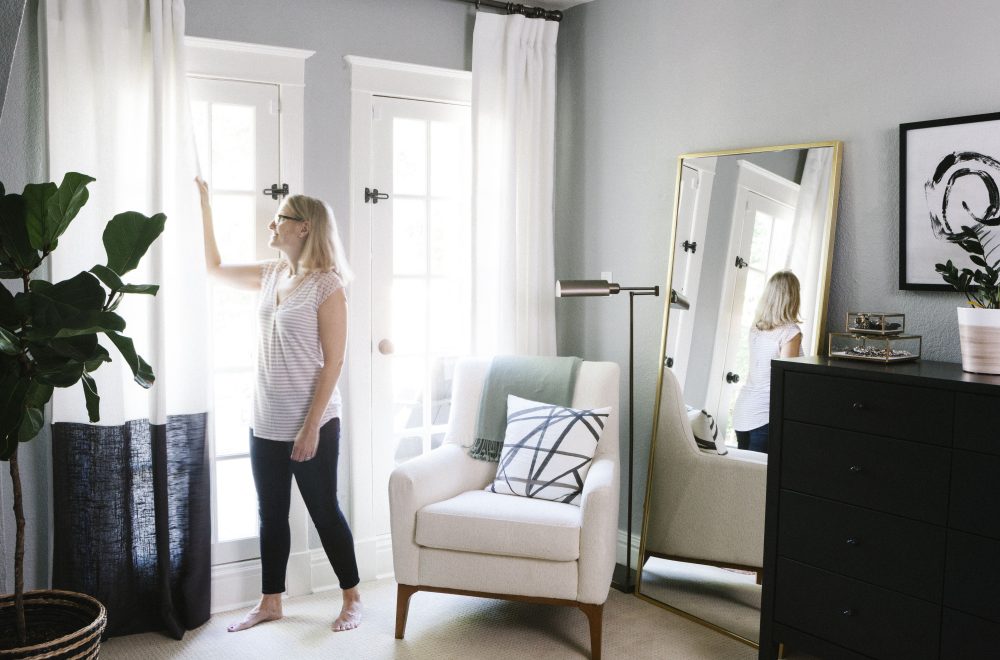While decorating my new home, I came up against many of the challenges and tough decisions Havenly clients face in every project; selecting window treatments was no exception. One of the features that originally sold us on our home was the large, historic windows with original trim. We didn’t want to completely cover them up but, of course, it was necessary to have some level of privacy.
After living in the house with no window treatments for a few weeks, it became apparent what our priorities were for the windows. Some windows didn’t require privacy, and we wanted to let as much light in as possible, while the street-facing windows would definitely need some notion of blocking visibility in the evening. Although we loved the original trim, it wasn’t in amazing shape, so we were okay with covering rough parts of it if that meant maintaining the openness of the large windows.
Type and sizing were the two main considerations that I kept in mind.
Type
The first decision should really consider the following:
- how you are going to use the space
- how much privacy you need
- if you need to block light or visibility
- what aesthetic you’re going for
While roman shades are my go-to solution for windows that have an obstacle beneath them (such as a radiator) or no wall space on either side for hanging rods, they also work well in bathrooms, kitchens or on smaller windows. Doubling up on window treatments by using roman shades with curtains as well is a great way to create a more formal, layered look.

Solar shades are a great solution for modern homes where you want privacy while also allowing sunlight to filter into your home. Often, you’ll see these used in urban high-rises or homes with large, modern windows. Bamboo shades are my go-to for inexpensive treatments that can be customized and are an easy way to add a bit of bohemian flair into your home. Having had these in my previous apartment, I love the look, but was ready for a change.

I tend to stay away from shutters and blinds as they can easily look cheap and dated, although plantation shutters can be very fitting for more traditional homes and function quite well for blocking light. Shutters tend to block too much light and add unnecessary weight to windows, but for some spaces, especially in the South, they are the most appropriate option.
You can never go wrong with curtain panels. I love to use curtain panels wherever possible, as I think they can elevate a room while adding texture and the illusion of bigger windows and higher ceilings. While panel styles and headers vary widely (from grommet, to tab-top, to euro-pleat), I prefer a flat panel top or box pleat in contemporary spaces, and usually use curtain rings as it allows for a more natural draping of the fabric.

Size
The next thing you’ll want to consider is the size of your window treatments. If you’re going with shades, shutters or blinds, it’s extremely important to take exact measurements of your windows and frames to get a perfect, custom fit. Curtains tend to be a bit simpler, coming in standard sizes, and require less customization in most cases.
One rule we always follow here at Havenly is to hang your curtains high and wide, and make sure the panels just graze the floor. This makes your windows feel larger and your ceilings feel taller.

The Winner: Curtain Panels
After weighing the options, I decided to go with floor to ceiling curtain panels from one of our favorite vendors, Loom Decor. The soft goods retailer has a wide variety of fabrics, linings, and header types and can do custom sizes for any of their window treatments. While I love some of their bolder, pattered fabrics, I knew I wanted some consistency in window treatments throughout the house. The rooms all open to each other, so the fabrics needed to feel somewhat cohesive. I’m always a fan of simple, white panels, but wanted something just a bit different to add a touch of interest against our solid white walls.
I debated between getting their colorblock panels and the leading edge border panels in white linen with black trim. Eventually I decided on the leading edge border panels as I felt they helped draw the eye up to our high ceilings, and the color accent wouldn’t be blocked if hung behind furniture. I also ordered a custom length just shy of our ceiling height to accommodate a rod and rings and allow the panels to just touch the floor, and pairing the panels with modern brass rods. For a bit of extra privacy, I went with a standard lining, which also allow as much light in as possible. While we’ll likely open and close the panels frequently in the living room, where the window faces the street, we’ll mostly leave the panels open on the sides of our house where there is less visibility.
We ended up using the same set of panels in our living room, sitting room and dining room, which are all connected and visible to one another. From the moment we hung the panels, we knew it was the right decision. They elevated the room, making it feel more lived in and cozy, yet also more formal and elegant. The panels were the first step in making our empty home feel welcoming and warm.
Stay tuned to see how the panels look hung up in our space!

